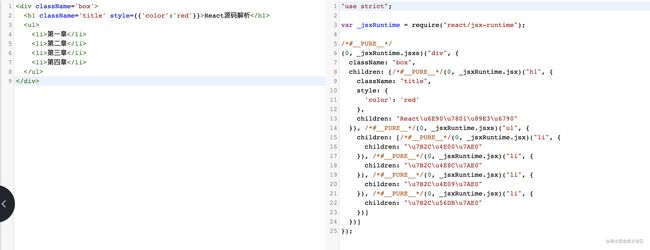react源码分析:babel如何解析jsx
同作为MVVM框架,React相比于Vue来讲,上手更需要JavaScript功底深厚一些,本系列将阅读React相关源码,从jsx -> VDom -> RDOM等一些列的过程,将会在本系列中一一讲解
工欲善其事,必先利其器
经过多年的发展,React已经更新了大版本16、17、18,本系列主要讲的是 version:17.0.2,在讲这个版本之前,我们先看一看在babel的编译下,每个大版本之下会有什么样的变化。
jsx
<div className='box'>
<h1 className='title' style={{'color':'red'}}>React源码解析</h1>
<ul>
<li>第一章</li>
<li>第二章</li>
<li>第三章</li>
<li>第四章</li>
</ul>
</div>
v16.x及以前版本
v17及之后版本
所以各位看到了,在v16及以前我们babel进行jsx解析编译的是根据@babel/babel-preset-react-app解析成React.createElement进行包裹的,而v17以及之后的版本,官网早就说明,对jsx的转换用react/jsx-runtime,而不再依赖React.createElement了,看到这里我想各位对不同版本的babel解析jsx已经有了眉目了,早已经迫不及待想去看看jsx-runtime和createElement到底是如何玩的,那么进入源码
在babel解析后的v17产物中我们可以看得到 var _jsxRuntime = require("react/jsx-runtime");那么我们追本溯源可以找到在packages/react/src/jsx/ReactJSX.js里面的jsxs是怎么来的
// packages/react/src/jsx/ReactJSX.js
import {REACT_FRAGMENT_TYPE} from 'shared/ReactSymbols';
import {
jsxWithValidationStatic,
jsxWithValidationDynamic,
jsxWithValidation,
} from './ReactJSXElementValidator';
import {jsx as jsxProd} from './ReactJSXElement';
const jsx = __DEV__ ? jsxWithValidationDynamic : jsxProd;
const jsxs = __DEV__ ? jsxWithValidationStatic : jsxProd;
const jsxDEV = __DEV__ ? jsxWithValidation : undefined;
export {REACT_FRAGMENT_TYPE as Fragment, jsx, jsxs, jsxDEV};
在非dev环境下我们继续去找jsProd
export function jsx(type, config, maybeKey) {
let propName;
//标签上的属性集合
const props = {};
//单独处理key ref
let key = null;
let ref = null;
if (maybeKey !== undefined) {
key = '' + maybeKey;
}
if (hasValidKey(config)) {
// 处理合法的key
key = '' + config.key;
}
if (hasValidRef(config)) {
// 处理合法的ref
ref = config.ref;
}
// 把属性加到props中
for (propName in config) {
if (
hasOwnProperty.call(config, propName) &&
!RESERVED_PROPS.hasOwnProperty(propName)
) {
props[propName] = config[propName];
}
}
// 处理默认props
if (type && type.defaultProps) {
const defaultProps = type.defaultProps;
for (propName in defaultProps) {
if (props[propName] === undefined) {
props[propName] = defaultProps[propName];
}
}
}
return ReactElement(
type,
key,
ref,
undefined,
undefined,
ReactCurrentOwner.current,
props
)
}
相关参考视频讲解:进入学习
ReactElement
const ReactElement = function(type, key, ref, self, source, owner, props) {
const element = {
// 表示是否为ReactElement
$$typeof: REACT_ELEMENT_TYPE,
// 元素自身属性
type: type,
key: key,
ref: ref,
props: props,
// Record the component responsible for creating this element.
_owner: owner,
};
if (__DEV__) {
element._store = {};
// 开发环境下将_store、_self、_source属性变为不可枚举
Object.defineProperty(element._store, 'validated', {
configurable: false,
enumerable: false,
writable: true,
value: false,
});
Object.defineProperty(element, '_self', {
configurable: false,
enumerable: false,
writable: false,
value: self,
});
Object.defineProperty(element, '_source', {
configurable: false,
enumerable: false,
writable: false,
value: source,
});
// 冻结props、element防止被手动修改
if (Object.freeze) {
Object.freeze(element.props);
Object.freeze(element);
}
}
return element;
};
这上面便是v17及之后版本的jsx-runtime所做的事情。那么这里再去看一下v16中的createElement所做的事情吧。
React.createElement
// packages/react/src/ReactElement.js
export function createElement(type, config, children) {
let propName;
// 记录标签上的属性集合
const props = {};
//单独处理key ref
let key = null;
let ref = null;
let self = null;
let source = null;
// 当config部位null的时候,表示标签上有属性,加到props里面去
if (config != null) {
// 合法的ref才做处理
if (hasValidRef(config)) {
ref = config.ref;
if (__DEV__) {
warnIfStringRefCannotBeAutoConverted(config);
}
}
if (hasValidKey(config)) {
// 有合法的key才做处理
key = '' + config.key;
}
// 记录信息用于debug
self = config.__self === undefined ? null : config.__self;
source = config.__source === undefined ? null : config.__source;
// 处理self,source,key,ref以外的属性,加入props中
for (propName in config) {
if (
hasOwnProperty.call(config, propName) &&
!RESERVED_PROPS.hasOwnProperty(propName)
) {
props[propName] = config[propName];
}
}
}
// 处理子节点
const childrenLength = arguments.length - 2;
// 单标签子节点
if (childrenLength === 1) {
props.children = children;
//嵌套子节点
} else if (childrenLength > 1) {
const childArray = Array(childrenLength);
for (let i = 0; i < childrenLength; i++) {
childArray[i] = arguments[i + 2];
}
//开发环境冻结,childArray防止被修改
if (__DEV__) {
if (Object.freeze) {
Object.freeze(childArray);
}
}
props.children = childArray;
}
// 处理默认props
if (type && type.defaultProps) {
const defaultProps = type.defaultProps;
for (propName in defaultProps) {
if (props[propName] === undefined) {
props[propName] = defaultProps[propName];
}
}
}
if (__DEV__) {
// dev环境下,key 与 ref不挂到props中去
if (key || ref) {
const displayName =
typeof type === 'function'
? type.displayName || type.name || 'Unknown'
: type;
if (key) {
defineKeyPropWarningGetter(props, displayName);
}
if (ref) {
defineRefPropWarningGetter(props, displayName);
}
}
}
// 调用返回
return ReactElement(
type,
key,
ref,
self,
source,
ReactCurrentOwner.current,
props,
);
}
由React.createElement源码得知,他做了如下事情
-
解析
config参数中是否有合法的key、ref属性,并处理,并将其他的属性挂到props上。 -
解析函数的第三参数,并分情况将第三参数挂到
props.children上。 -
对默认props进行处理,如果存在该属性则直接挂载到props上,不存在则要添加上。
-
开发环境下将
_store、_self、_source设置为不可枚举状态,为后期的diff比较作优化,提高比较性能。 -
将
type、key、ref、props等属性通过调用ReactElement函数创建虚拟dom。
ReactElement
const ReactElement = function(type, key, ref, self, source, owner, props) {
const element = {
// This tag allows us to uniquely identify this as a React Element
$$typeof: REACT_ELEMENT_TYPE,
// Built-in properties that belong on the element
type: type,
key: key,
ref: ref,
props: props,
// Record the component responsible for creating this element.
_owner: owner,
};
if (__DEV__) {
// The validation flag is currently mutative. We put it on
// an external backing store so that we can freeze the whole object.
// This can be replaced with a WeakMap once they are implemented in
// commonly used development environments.
element._store = {};
// To make comparing ReactElements easier for testing purposes, we make
// the validation flag non-enumerable (where possible, which should
// include every environment we run tests in), so the test framework
// ignores it.
Object.defineProperty(element._store, 'validated', {
configurable: false,
enumerable: false,
writable: true,
value: false,
});
// self and source are DEV only properties.
Object.defineProperty(element, '_self', {
configurable: false,
enumerable: false,
writable: false,
value: self,
});
// Two elements created in two different places should be considered
// equal for testing purposes and therefore we hide it from enumeration.
Object.defineProperty(element, '_source', {
configurable: false,
enumerable: false,
writable: false,
value: source,
});
if (Object.freeze) {
Object.freeze(element.props);
Object.freeze(element);
}
}
return element;
};
仔细瞧一瞧,这个其实跟jsxs调用的ReactElement实现的差不多的功能,但是为什么要写两遍?仔细看来,在两个版本的ReactElement中,传入的参数不一致,在开发环境下,分别对其做劫持不可枚举状态,仅此而已
?
React.Component
写惯了hooks组件,但是Class组件也别忘了哟,因为在React17里面Class组件也是没有被抹去的,所以既然是源码解析,那么我们也要来看一看这个Component到底干了啥。
// packages/react/src/ReactBaseClasses.js
function Component(props, context, updater) {
// 接受各种参数,挂到this上
this.props = props;
this.context = context;
this.refs = emptyObject;
// updater ??
this.updater = updater || ReactNoopUpdateQueue;
}
// 原型上挂载了isReactComponent用来区分函数组件与类组件
Component.prototype.isReactComponent = {};
//原型上挂载了setState方法用来触发更新
Component.prototype.setState = function(partialState, callback) {
invariant(
typeof partialState === 'object' ||
typeof partialState === 'function' ||
partialState == null,
'setState(...): takes an object of state variables to update or a ' +
'function which returns an object of state variables.',
);
// 调用updater上的enqueueSetState方法???
this.updater.enqueueSetState(this, partialState, callback, 'setState');
};
// 原型上挂载了强制更新的方法
Component.prototype.forceUpdate = function(callback) {
this.updater.enqueueForceUpdate(this, callback, 'forceUpdate');
};
从源码上可以得知,React.Component 主要做了以下几件事情:
- 将
props, context, updater挂载到this上,props,context一目了然,后面的updater位触发器,上面挂了很多方法,我们后面再谈。 - 在
Component原型链上添加isReactComponent对象,用于区分函数组件还是类组件。 - 在
Component原型链上添加setState方法,触发更新。 - 在
Component原型链上添加forceUpdate方法,强制更新。
总结
不管是类组件还是函数组件,最终我们写的jsx都被babel转化成了可识别的元素,其中我们也看了ReactElement,createElement,Component等内部实现,了解到了作为ReactElement他是怎么被创建的,但是远远没有完,因为我们知道我们在写React的时候,会在后面带上一个ReactDOM.render(,没错我们下一章节就要去探索一下ReactDOM.render方法了。

